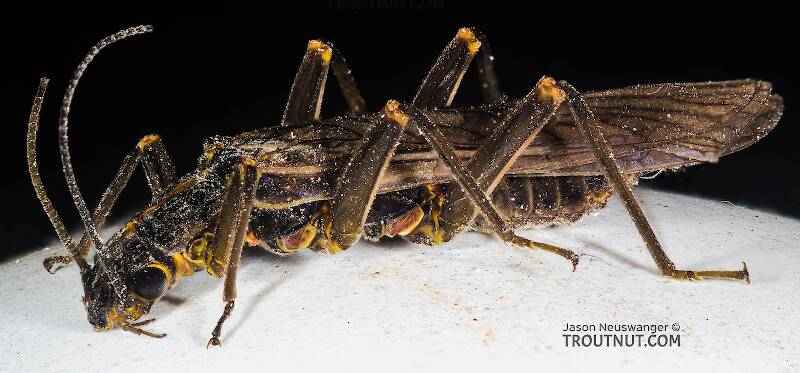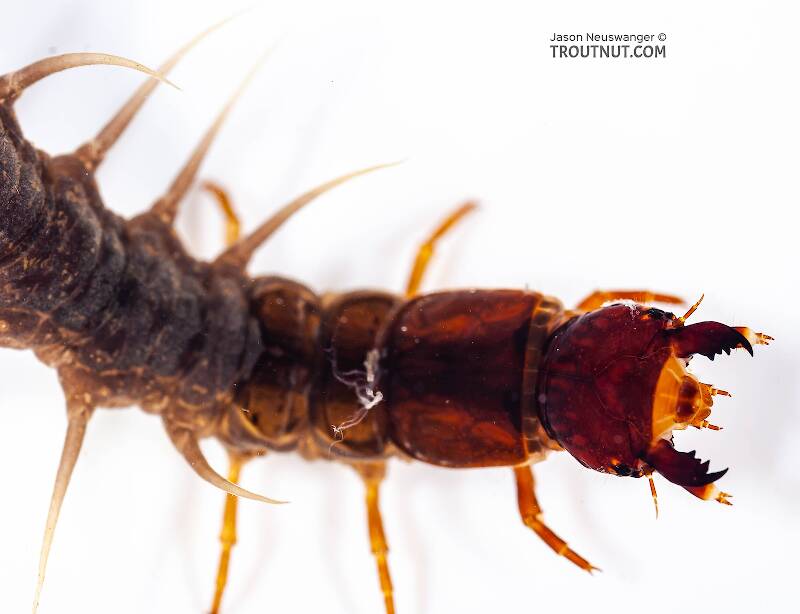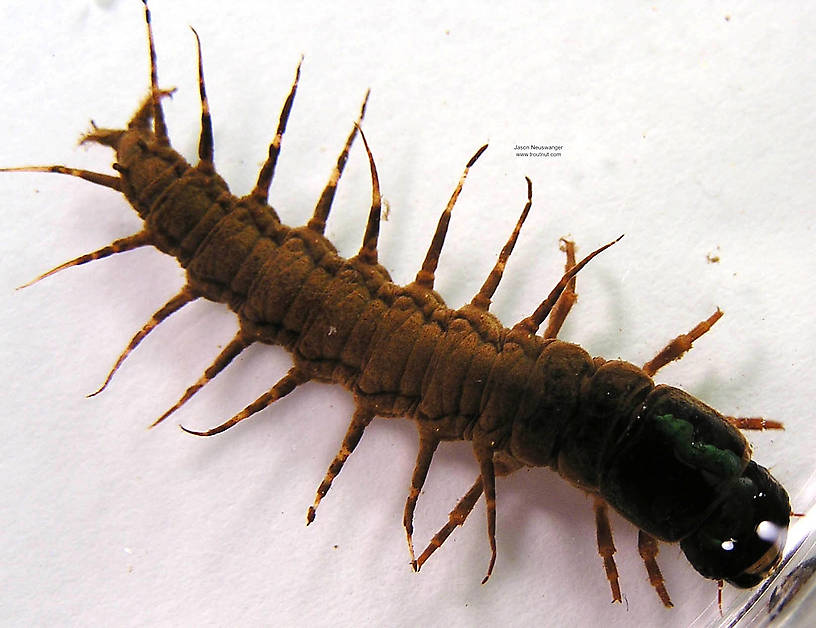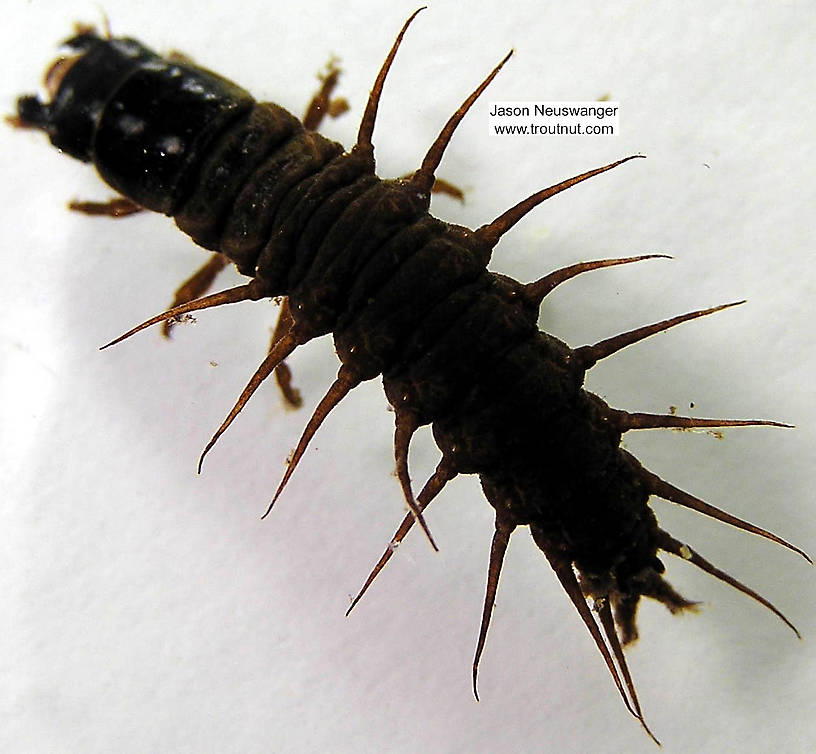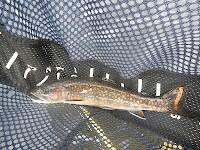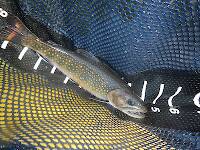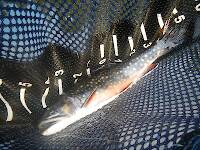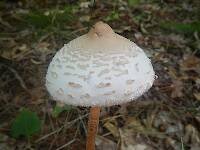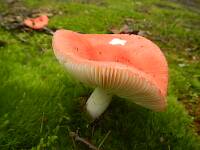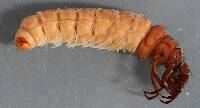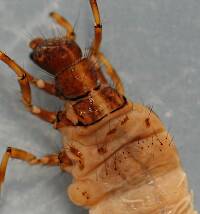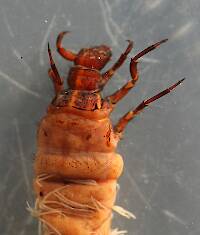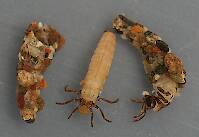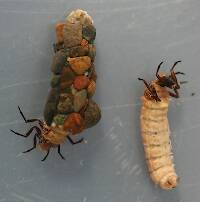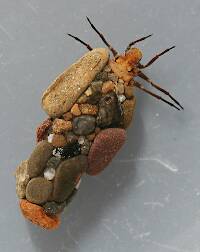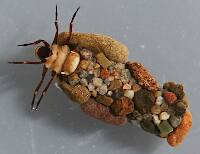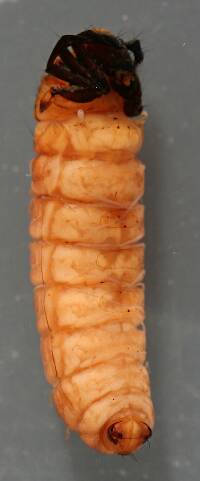
Hex Mayflies
Hexagenia limbata
The famous nocturnal Hex hatch of the Midwest (and a few other lucky locations) stirs to the surface mythically large brown trout that only touch streamers for the rest of the year.
Featured on the forum

Troutnut is a project started in 2003 by salmonid ecologist Jason "Troutnut" Neuswanger to help anglers and
fly tyers unabashedly embrace the entomological side of the sport. Learn more about Troutnut or
support the project for an enhanced experience here.
This topic is about the Hellgrammite Genus Nigronia
This seems to be the most common trout stream dobsonfly genus.Example specimens
Ofieldstrea on Jun 24, 2007June 24th, 2007, 5:52 am EDT
Troutnut ... the term "hellgramite" is reserved for the Dobsonfly (Corydalinae). Though the Fishfly (Chauliodinae) and the dobsonfly are from the same Megaloptera family, at first glance appear similar, and have similar stages of development, they are from different subfamily with differing subspecies and have very different morphology and biology.
The dobsonfly inhabit the more oxygenated waters of riffles and possess only tuffed gills for respiration. The fishfly inhabit the quiter waters of pools and still water. Fishflies have a primative gills called lateral filaments, while some species of fishfly utilize breathing tubes, located posterior, to accomodate the use of atmospheric oxygen for breathing in low dissolved oxygen envirions while remaining submerged.
So .. it is incorrect to use the term 'hellgramite' when talking about the fishfly larvae. They are simply, 'fishfly larvae'. You really should change your reference.
---- Reference -----
McCafferty, W. Patrick, 1981. Aquatic Entomology; Chpt. 11, Fishflies, Dobsonflies and Alderflies (order Megaloptera), p. 189-196
--------------------------
O'fieldstream
The dobsonfly inhabit the more oxygenated waters of riffles and possess only tuffed gills for respiration. The fishfly inhabit the quiter waters of pools and still water. Fishflies have a primative gills called lateral filaments, while some species of fishfly utilize breathing tubes, located posterior, to accomodate the use of atmospheric oxygen for breathing in low dissolved oxygen envirions while remaining submerged.
So .. it is incorrect to use the term 'hellgramite' when talking about the fishfly larvae. They are simply, 'fishfly larvae'. You really should change your reference.
---- Reference -----
McCafferty, W. Patrick, 1981. Aquatic Entomology; Chpt. 11, Fishflies, Dobsonflies and Alderflies (order Megaloptera), p. 189-196
--------------------------
O'fieldstream
J. Leslie Booth
O'fieldstream Outdoor Journal
ofieldstream@gmail.com
www.ofieldstream.com
O'fieldstream Outdoor Journal
ofieldstream@gmail.com
www.ofieldstream.com
Troutnut on Jun 24, 2007June 24th, 2007, 7:57 am EDT
It's a tough call and I'm open to suggestions. I know that when just about any angler picks up a fishfly larva, he'll call it a hellgrammite. So the common name of hellgrammite is widely used (or misused) to describe fishfly larvae. I've tried to keep the common names on this site compliant with general usage rather than technical accuracy, because the latter is a lost cause with most common names, anyway.
I'd like to see what other members think about this. I would be willing to change it if many others really cringe to see fishfly larvae called hellgrammites. Otherwise, I may just make a note about the distinction on the 'hellgrammite' common name page.
I'd like to see what other members think about this. I would be willing to change it if many others really cringe to see fishfly larvae called hellgrammites. Otherwise, I may just make a note about the distinction on the 'hellgrammite' common name page.
Jason Neuswanger, Ph.D.
Troutnut and salmonid ecologist
Troutnut and salmonid ecologist
Taxon on Jun 24, 2007June 24th, 2007, 9:35 am EDT
Jason-
JLB is correct.
Given that you arguably have the leading entomology site on the net, perhaps you should entertain leading the masses away from the abyss, rather that simply accommodating their use of faulty terminology. LOL.
JLB is correct.
Given that you arguably have the leading entomology site on the net, perhaps you should entertain leading the masses away from the abyss, rather that simply accommodating their use of faulty terminology. LOL.
Entoman on Jun 27, 2011June 27th, 2011, 10:52 pm EDT
Ofieldstrea -
By whom? I'd like to have a talk with them about "ruling" on Blue Winged Olive's and "Flavs", among others.
Really? Even Merritt (Aquatic Insects of North america) refers to all the larger Megalopteran larvae as "Hellgrammites" with no other common name mentioned. Better stop the presses. Oops! Too late...
Assuming a typo or mistaken paraphrasing and what was meant was "the same family (Corydalidae) in the order Megaloptera", the information provided in most references is now based on the different genera. The subfamily and subspecies comments refer to older taxonomic reviews I think (like the one you mentioned for reference), though I don't remember any that skipped over the genera and species in between, nor do I remember subspecies at all for that matter. As insects go this is a pretty small order with less than 300 species worldwide.
I don't know about "very different". Yes, they're pretty easy to tell from a stonefly or a giraffe for that matter, but they still look darn close to each other, even to the more studied observer.
I sympathize with your desire to promote better and more consistant use of common names. Heck, all serious practioners of the sport do. Separating the larvae with two different common names is a good suggestion. But I must take issue with your insinuation that this website is spreading error regarding these critters, because it isn't. The truth is, there's more people out there calling them "Fish Wigglers" or "Biter Bugs" than Fishfly Larvae. In fact, the error would be to report "Fishfly larvae" as THE "common name" when unfortunately, it clearly isn't. Probably 5 or 6 out of a list of 5 or 6.
Jason -
Exactly... The terms "technically accurate" and "common name" are two concepts seemingly incapable of reconciliation and are most often mutually exclusive, almost by definition.
On the other hand, Taxon does make a good point that attempts should be made to clarify confusion over common nomenclature whenever possible and promote better usage. Though, I must admit at times it feels like attempting to bale out the ocean with a water bucket. Not that it's worth losing sleep over because "technical accuracy" is what the Latin's for anyway.
On a different note, the connection of this thread to one in current discussion is now practical due to the new "related discussions" category in the forum. This new category should prove invaluable when pondering bug photo determinations as well as easily finding relevant contributions for other types of ongoing discussions. How many times do we have dim recollections of great comments or ideas expressed that would be great to include if we could only find them? If you ever have a deja vu, I strongly recommend taking advantage of this feature. Kudo's Jason.
Kurt
Troutnut ... the term "hellgramite" is reserved for the Dobsonfly (Corydalinae).
By whom? I'd like to have a talk with them about "ruling" on Blue Winged Olive's and "Flavs", among others.
So .. it is incorrect to use the term 'hellgramite' when talking about the fishfly larvae. They are simply, 'fishfly larvae'. You really should change your reference.
Really? Even Merritt (Aquatic Insects of North america) refers to all the larger Megalopteran larvae as "Hellgrammites" with no other common name mentioned. Better stop the presses. Oops! Too late...
Though the Fishfly (Chauliodinae) and the dobsonfly are from the same Megaloptera family, at first glance appear similar, and have similar stages of development, they are from different subfamily with differing subspecies...
Assuming a typo or mistaken paraphrasing and what was meant was "the same family (Corydalidae) in the order Megaloptera", the information provided in most references is now based on the different genera. The subfamily and subspecies comments refer to older taxonomic reviews I think (like the one you mentioned for reference), though I don't remember any that skipped over the genera and species in between, nor do I remember subspecies at all for that matter. As insects go this is a pretty small order with less than 300 species worldwide.
... and have very different morphology and biology.
I don't know about "very different". Yes, they're pretty easy to tell from a stonefly or a giraffe for that matter, but they still look darn close to each other, even to the more studied observer.
I sympathize with your desire to promote better and more consistant use of common names. Heck, all serious practioners of the sport do. Separating the larvae with two different common names is a good suggestion. But I must take issue with your insinuation that this website is spreading error regarding these critters, because it isn't. The truth is, there's more people out there calling them "Fish Wigglers" or "Biter Bugs" than Fishfly Larvae. In fact, the error would be to report "Fishfly larvae" as THE "common name" when unfortunately, it clearly isn't. Probably 5 or 6 out of a list of 5 or 6.
Jason -
I've tried to keep the common names on this site compliant with general usage rather than technical accuracy, because the latter is a lost cause with most common names, anyway.
Exactly... The terms "technically accurate" and "common name" are two concepts seemingly incapable of reconciliation and are most often mutually exclusive, almost by definition.
On the other hand, Taxon does make a good point that attempts should be made to clarify confusion over common nomenclature whenever possible and promote better usage. Though, I must admit at times it feels like attempting to bale out the ocean with a water bucket. Not that it's worth losing sleep over because "technical accuracy" is what the Latin's for anyway.
On a different note, the connection of this thread to one in current discussion is now practical due to the new "related discussions" category in the forum. This new category should prove invaluable when pondering bug photo determinations as well as easily finding relevant contributions for other types of ongoing discussions. How many times do we have dim recollections of great comments or ideas expressed that would be great to include if we could only find them? If you ever have a deja vu, I strongly recommend taking advantage of this feature. Kudo's Jason.
Kurt
"It's not that I find fishing so important, it's just that I find all other endeavors of Man equally unimportant... And not nearly as much fun!" Robert Traver, Anatomy of a Fisherman
Troutnut on Jun 28, 2011June 28th, 2011, 1:11 am EDT
If you ever have a deja vu I strongly recommend taking advantage of this feature. Kudo's Jason.
Glad you're finding it useful! I was pretty excited when I figured out how I could build that feature. The algorithm (based on shared, uncommon words) isn't perfect, but it usually finds something relevant if it's out there.
Naturally I agree with the rest of your comment about nomenclature, as well, and disagree with Roger's old (2007) comment. I think common names are defined by their usage, and fuzziness and inconsistency are unavoidable. Evangelizing for some vision of "proper" usage would only confuse casual users, and users with enough advanced knowledge to notice a problem are also smart enough to find their way around any confusion it might cause them. They also, hopefully, can sympathize with this point even if they disagree.
Jason Neuswanger, Ph.D.
Troutnut and salmonid ecologist
Troutnut and salmonid ecologist
PaulRoberts on Jun 28, 2011June 28th, 2011, 5:33 am EDT
I have only one thing to add to Kurt's excellent response to the huffing and puffing going on here about a common name:
What McCafferty actually says in his layperson's guide to macroinverts "Aquatic Entomology" is that "Dobsonfy and Fishfly larvae (he does mention both separately) usually occur in well-oxygenated flowing water. SOME fishfly ...obtain atmospheric oxygen via a pair of elongate breathing tubes." We trout fishers are not talking about those.
From Merriam Webster:
Definition of HELLGRAMMITE
: a carnivorous aquatic North American insect larva that is the young form of a dobsonfly (especially Corydalis cornutus) and is used for fish bait
See hellgrammite defined for kids »
Origin of HELLGRAMMITE:
origin unknown
First Known Use: 1866
So...did the originators of this common name know the difference between dobsonfly and fishfly? Would one interchange with the other for bait?
I'm going to stick to "hellgrammite" for the larger Megaloptera larvae, when talking fly patterns. For Alderfly larvae, I just call them "Sialids".
Yes, kudos to Jason for the related topics feature. I've never seen it before on other sites and...darn if it doesn't actually work. Very helpful.
What McCafferty actually says in his layperson's guide to macroinverts "Aquatic Entomology" is that "Dobsonfy and Fishfly larvae (he does mention both separately) usually occur in well-oxygenated flowing water. SOME fishfly ...obtain atmospheric oxygen via a pair of elongate breathing tubes." We trout fishers are not talking about those.
From Merriam Webster:
Definition of HELLGRAMMITE
: a carnivorous aquatic North American insect larva that is the young form of a dobsonfly (especially Corydalis cornutus) and is used for fish bait
See hellgrammite defined for kids »
Origin of HELLGRAMMITE:
origin unknown
First Known Use: 1866
So...did the originators of this common name know the difference between dobsonfly and fishfly? Would one interchange with the other for bait?
I'm going to stick to "hellgrammite" for the larger Megaloptera larvae, when talking fly patterns. For Alderfly larvae, I just call them "Sialids".
Yes, kudos to Jason for the related topics feature. I've never seen it before on other sites and...darn if it doesn't actually work. Very helpful.
Quick Reply
Related Discussions
Topic
Replies
Last Reply
8
Sep 23, 2018
by Jmd123
by Jmd123
16
May 20, 2008
by Shawnny3
by Shawnny3
14
Mar 24, 2009
by GONZO
by GONZO
1
May 17, 2016
by Bnorikane
by Bnorikane


